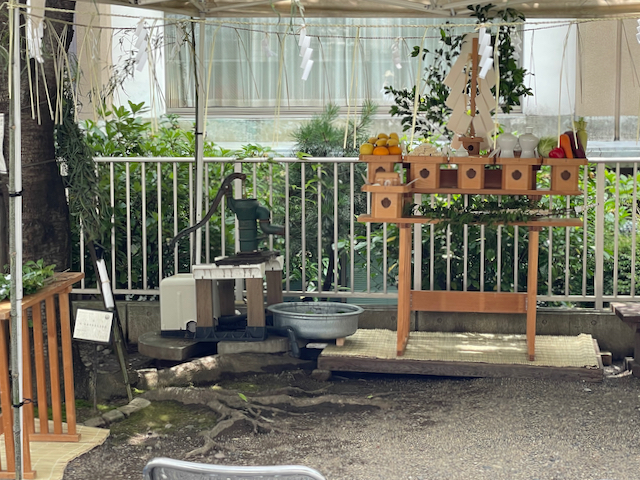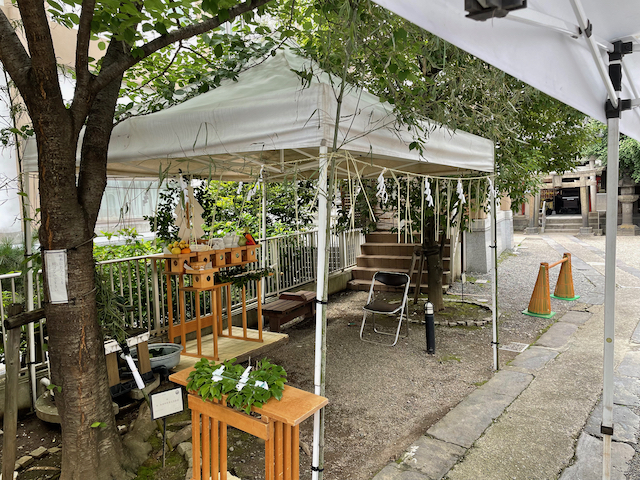While I was volunteering at Asakusa Jinja’s natsumoude, on July 7th, the jinja held a special ceremony, or “shinji”, to symbolically clean and purify the well in the jinja precincts. This was called the “Ido Arai Shinji”, or “Well-Washing Ceremony”. This was listed in the program for natsumoude, which we were handing out, and was announced several times over the PA system in the jinja, but even so not many people went to see it. (It was at 2pm on a weekday, but there were quite a lot of people around in the jinja even so.)
The ceremony was held at the well, which is at the side of the car park behind the jinja office. The ritual site was prepared with marquees and folding chairs, and, more importantly, offerings for the kami and the tools for the ceremony, as you can see in the pictures, which show the sacred space for the ceremony itself, rather than the area where attendees were sitting. These photographs were taken before the ceremony began, so all of the tools are set up, but nothing has yet been used. You can see that the offerings have already been set out, on the upper level of the double shelves towards the right of the first picture. (They were in the centre of that side of the sacred area, but there were more items to one side of the space, so they are off centre in the picture.) The items on the lower shelf are not offerings; I will explain what they are later.
The large gohei (the lightning bolt strips of paper on the wooden pole) and the large sakaki branch in the centre of the upper shelf are the yorishiro, the place that the kami will inhabit during the ceremony. As the ceremony had not started at this point, there were no kami in them when I took the photographs.
Two priests officiated at the ceremony, and there was also one person, who may also have been a priest, playing a shō, one of the traditional instruments used in Shinto sacred music. The senior priest was female, while the junior priest was male and, as he was wearing white hakama, may not actually have been a fully qualified priest. They started by processing to the ritual area, with the junior priest leading the procession. As there were only two priests, this was slightly odd, but it does fit the normal practice.
Once they had taken their places, the junior priest performed the harai, the purification. After reciting the haraëkotoba, the standard purification prayer, he took the large sakaki branch on the lower of the double shelves, and waved that to purify all the items and people involved in the ritual, which included me, as an attendee.
Then the kami were called down into the gohei. During this part, all the attendees had to stand and bow their heads. I believe that the senior officiating priest intones a quiet norito to invite the kami, while the junior priest performs the keihitsu, which is a long “ooooh” sound, rising in pitch and volume and then falling again. However, I am not entirely sure about the norito.
Once the kami are present, the offerings are presented. As the offerings were already in place, this involved the junior priest removing the lids from the water and sakë vessels. That is an entirely standard form.
The next step was the norito, the formal prayer, which was intoned by the senior priest. One interesting feature of this ceremony was that the priests wore masks for most of the ceremony, only removing them in order to recite norito. They removed their mask and placed it in the sleeve of their vestments before going before the kami, and then replaced their mask after reciting the norito, but before returning to their place. I do not know how general that is, but it seems that Asakusa Jinja, at least, has worked out a place for face masks in Shinto ritual.
After the norito, three people symbolically cleaned the well, using the stick with leaves wrapped around it that is leaning against the tree in the left of the first picture. This involved thrusting it three times into the opening of the well, shouting “Ei!” each time. The three people were the chief priest of the jinja, the head of the committee organising the natsumoude, and someone else whose status I didn’t quite catch.
Next, the senior priest purified the well. For this, she used the items on the wooden stand at the left of the lower shelf. There were three types of stuff, and for each she took three pinches, holding each pinch briefly in front of her face before throwing it over the well. The last one was small squares of white cloth, which would traditionally be hemp — I am not sure whether it actually was in this case. The first two were harder to see, but they were both white, and I guess that the first one was rice, and the second one salt, because those are common choices, and would have looked and sounded like that. She also placed something on the pump handle, but I could not see exactly what that was; it looked like a small ring of shimënawa.
The priest then pumped the well three times, saying “Ei!” as she pumped, splashing water into the basin you can see next to the well.
After that, all the attendees offered tamagushi. You can see these better in the second photograph, on the table (the an) in the foreground. The priest offered one first, and then the three people who had cleaned the well did so. Next, everyone who had attended offered tamagushi and paid reverence in the normal way (two bows, two claps, one bow). This was a bit of a surprise for us, because we had not expected to be so involved.
With the ceremony finished, the lids were replaced on the water and sakë, and the kami dismissed, with another keihitsu. The presiding priest then gave a short talk on the significance of the ritual, which is to do with the importance of water, and praying for good health, before the priests processed out.
Finally, the chief priest gave a short talk, explaining that he created this ceremony eight years ago, based on traditions from the Edo period (pre-1868). He emphasised the importance of water, and that we should remain grateful for it even with the ease of access of mains water, and asked us to remember that there was a hand-operated well in the jinja grounds. In the event of a major earthquake in Tokyo, which is a matter of “when”, not “if”, that could be quite important for people who live a bit closer than I do. He also mentioned that, in the Edo period, people ate sōmen, a kind of noodle, while cleaning the wells, and so we all got a pack of sōmen, together with a pair of Asakusa Jinja chopsticks and a pack of Asakusa Jinja seaweed, as o-sagari. These had been offered to the kami during the ceremony, and you can see them in the photographs. The sōmen is the rectangular white bundles to the left of the gohei as we look at it, while the chopsticks and seaweed are in white envelopes behind the sakë bottles, to the right of the gohei.
As you can probably tell from the length of this post, I found this ceremony very interesting. It is also a very good example of a new ceremony created from traditional elements; I would have believed the chief priest if he had said it was centuries old. It is also, of course, interesting that he did not feel the need to do that, and was perfectly happy to admit that he had made it up. As I have mentioned before, the importance placed on tradition in mainstream Shinto is not generally combined with hostility to the new.


Very interesting! Thank you for reporting and detailing this small ceremony. I really like how the priest emphasized how we should appreciate and be thankful for even the small things that give us life. I also love how the offerings became souvenirs for the event.